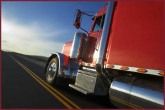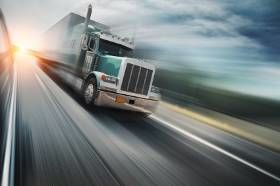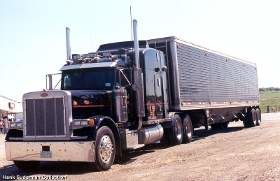Oh My Gosh What Else Can Go Wrong??
Topic 16012 | Page 2

Keep your head up man, definitely praying for ya!
The load locks arent recommended by my company and we only use load straps thst my company provides to us for free.
The reason load locks dont work well is that the newer dry van trailers are lighter weight and the walls are thin and flexible and load locks simply dont hold when the trailer walls flex. We haul alot of food and beverage products, heavy forklifts, tall paper rolls etc. Unstable heavy stuff. To protect the freight we are also told to take all ramps at half speed and if we have any hatd brakes especially with the paper, we are to notify the company and they arrange for the load to be checked to make sure no rolls have shifted and are leaning. Sure its expensive, but much cheaper than having 8,000 lb rolls of paper come through the side of a trailer possibly killing someone.
Ive only had 1 pallet come apart on me so far. It was product headed for the Safeway DC in Denver. They were able to accept the entire load but it took longer for them to count and restack everything.
Dry Van:
A trailer or truck that that requires no special attention, such as refrigeration, that hauls regular palletted, boxed, or floor-loaded freight. The most common type of trailer in trucking.
I recently took 40K pallets of talc from Southern Montana to Oregon, via Helena (had to get some work done on my truck and light replaced on trailer). After I got out of the shop I checked the load, glad I did. The last two pallets had shifted enough that our yard workers moved the pallets where they were supposed too. I used three straps, two cross-ways and one on the bottom-across, when I got to the receiver and opened my doors the pallets didn't shift an inch. The receiver even said they haven't seen a good secure job like that in while.
My new (and still new) practice is, that if the load isn't already sealed, I'll strap the load down and if it is a live unload I'll put my straps on then put the shipper's seal on. If it is a drop, I'll put one of our seals on after I secure the load, and when I get to the drop I'll take our seal off and put the receiver's on, drop the load and leave.
^scott
p.s. securing load reminds me of securing for sea in my Navy dayz.
Shipper:
The customer who is shipping the freight. This is where the driver will pick up a load and then deliver it to the receiver or consignee.
Im in agreement with everyone on the straps. They are the way to go. As was previously mentioned, easier to handle and store too.
So I hopped in the back this morning to strap down the remainder of the load, and APPARENTLY this trailer only has the slots for straps at the very top. So straps wouldn't have worked anyway. This trailer had a weird number--GH followed by four numbers--so I'm guessing this trailer is just "different."
I know how u feel. I do beer runs all the time... but Sam Adams in Cincinnati is just plain scary and dangerous. Crack addicts walk around and follow and harass you...you park on a city street and walk around the corner to security. The criminals know how long it will take you and try to break into the trucks. I chased one guy with my hammer. I was there a couple days ago and it was so dark... I forgot to put the load locks in cause I did not feel safe moving the tandems and wanted to get out of there.
Once on the road I realized my mistake. Thank God I drove thru oh and in....without major inclines.
Tandems:
Tandem Axles
A set of axles spaced close together, legally defined as more than 40 and less than 96 inches apart by the USDOT. Drivers tend to refer to the tandem axles on their trailer as just "tandems". You might hear a driver say, "I'm 400 pounds overweight on my tandems", referring to his trailer tandems, not his tractor tandems. Tractor tandems are generally just referred to as "drives" which is short for "drive axles".
Tandem:
Tandem Axles
A set of axles spaced close together, legally defined as more than 40 and less than 96 inches apart by the USDOT. Drivers tend to refer to the tandem axles on their trailer as just "tandems". You might hear a driver say, "I'm 400 pounds overweight on my tandems", referring to his trailer tandems, not his tractor tandems. Tractor tandems are generally just referred to as "drives" which is short for "drive axles".
I know how u feel. I do beer runs all the time... but Sam Adams in Cincinnati is just plain scary and dangerous. Crack addicts walk around and follow and harass you...you park on a city street and walk around the corner to security. The criminals know how long it will take you and try to break into the trucks. I chased one guy with my hammer. I was there a couple days ago and it was so dark... I forgot to put the load locks in cause I did not feel safe moving the tandems and wanted to get out of there.
Once on the road I realized my mistake. Thank God I drove thru oh and in....without major inclines.
Damn. I've been lucky so fsr and haven't had to go anywhere very "sketchy" so far.
As far as the load locks, I asked another Swifty about it and he said sometimes he puts a 2-3" thick wooden block on one end of the load lock since sometimes these load locks aren't long enough. He said he's had the load locks fall down before but never had the load shift like that.
Tandems:
Tandem Axles
A set of axles spaced close together, legally defined as more than 40 and less than 96 inches apart by the USDOT. Drivers tend to refer to the tandem axles on their trailer as just "tandems". You might hear a driver say, "I'm 400 pounds overweight on my tandems", referring to his trailer tandems, not his tractor tandems. Tractor tandems are generally just referred to as "drives" which is short for "drive axles".
Tandem:
Tandem Axles
A set of axles spaced close together, legally defined as more than 40 and less than 96 inches apart by the USDOT. Drivers tend to refer to the tandem axles on their trailer as just "tandems". You might hear a driver say, "I'm 400 pounds overweight on my tandems", referring to his trailer tandems, not his tractor tandems. Tractor tandems are generally just referred to as "drives" which is short for "drive axles".

If you aren't running a temperature-controlled trailer, load locks and the walls of the trailer can change shape significantly enough to make a difference in load security due to temperature changes.
This is discounting the possibility of the walls of your trailer simply being flimsy.
Straps hold loads in place by pulling the walls of the trailer inward, while locks push outward. If a lock cools sufficiently from the time it was installed. (Say, loaded in daylight, on asphalt, then overnight on a dirt lot in a northern midwest state.) it might fall. If a strap cools, it gets tighter.
This is why you should precool your load locks in a temperature controlled trailer before you arrive at a shipper. If you take them off the rack at the back of your truck at 100+ degrees and put them in the trailer holding a -20 load, they are much more likely to fall.
If you put multiple load locks in place, you have to be careful that later locks do not loosen the locks that were placed before. Normally this means you place locks at mid-height on the trailer wall first, then lower/higher, and try to pull every lock out of position after all locks have been placed.
Shipper:
The customer who is shipping the freight. This is where the driver will pick up a load and then deliver it to the receiver or consignee.
OOS:
When a violation by either a driver or company is confirmed, an out-of-service order removes either the driver or the vehicle from the roadway until the violation is corrected.

The only loads I refuse are beer loads! Found myself restacking kegs because they bent my load locks. They said if I didn't stack them myself they wouldn't unload me! Put myself on the do not call list after almost breaking my back 2 pallets high
New Reply:
New! Check out our help videos for a better understanding of our forum features

















Preview:
This topic has the following tags:
Advice For New Truck Drivers Load Securement Safe Driving Tips







 TT On Facebook
TT On Facebook
Check out Allie Knight's beer run. It's a good one.